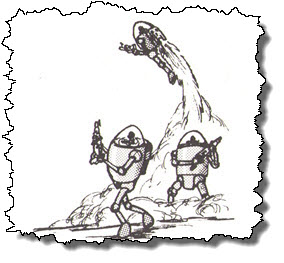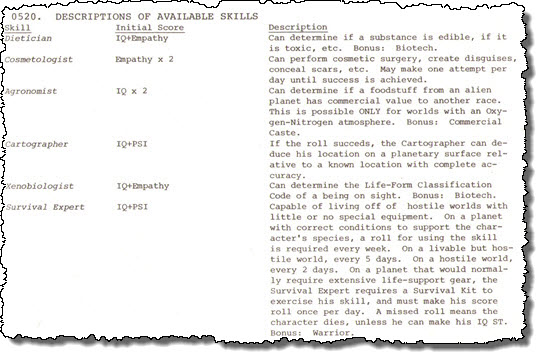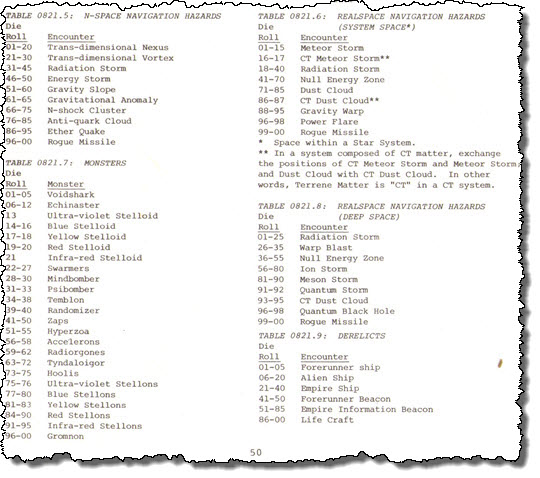Space Quest II
Space Quest II
The Wrath Of VohaulQuest
See, When I Was Researching Space Quest Last Week, There Were A Gigaquad More Links To The Classic Sierra Game
So, I Figure, Let’s Stick A Reference In And See If It Gets Me Some More Hits This Week
Maybe Even The Double Digits! Whoo!
When last we left our intrepid protagonist, he, she, or it was a nameless collection of statistics from a 2G world, which gave the aforementioned indeterminate pronoun some significant advantages with (so far) no notable drawbacks.
Let’s make them a Him, and call him Dirk. Dirk Venture? No, everyone will think I’m referring to that Johnny Quest parody I’ve never seen but everyone else has, with the bee lady. I know there’s a bee lady because, since all my friends have seen it, bits of it have sunk into my consciousness via osmosis. Dirk Gently? Obviously not. Dirk Destiny! Has a nice, space opera ring to it. (Change it to “Dick Destiny”, and he’s a character in some Horatio Alger story. Or a gay porn star. Or both.)
Abreactions & Adjustments
Gravity Abreaction
The use of the term “abreaction” is omnipresent in Space Quest, which is interesting. Per Google and Wikipedia, the term is used only in the realm of psychology, but here, it’s used for “anything negative”.
Anyhoo, the Gravity Abreaction table is used when the character is exposed to gravity over three times his own, with excessively worse effects for higher multiples. A roll of ‘6’ on the 1d6 table equals ‘death’. Again, since the rules are based on multiples of native ‘G’, there’s a profound advantage for those from high-G worlds. Dirk, from a 2G world, will not suffer abreaction until 6G, and suffers no penalties at all until 4G. (Spacers and silicoids get a +4 to save vs. gravity, and have a -1 modifier on the table.)
Ability Adjustment
You can do something about your crappy stats, if you wish, using a table which determines the cost of trading ability points. Indicating the nascent understanding that some abilities are more equal than others (and following a template begun in OD&D), it’s not a 1-1 swap. For example, you must sacrifice three points of IQ to buy 1 point of Physical Power, or four points of Physical Power for 1 point of IQ. Nor are all swaps permitted; PSI can only be paid for with IQ or Vitality.
It’s a very typical mechanic for the era. (Early D&D had something like this, except without a convenient table; it was all laid out in text and buried in odd places in the first Little Brown Book.) I’m sure it embodied, in the authors’ minds, some sort of inherent “realism” or “balance”, but it looks like a bit of a mess to me. In keeping with my reference to this time period as the “Burgess Shale” era of gaming, I can see subsystems like this as the earliest prototype of later point-buy systems, where different abilities had different costs, based on the perceived utility in the game (Champions being the Platonic ideal of this.)
Castes & Classes
And Saving Throws, but that doesn’t begin with ‘C’.
Saving Throws (which are, naturally, referred to long before they’re defined)[1], are based on ability scores. Various hazards specify the ability used to save against. In the “Everything old is new again” department, this is exactly what the current (Fifth) edition of D&D does. The formula for the basic save is 20 – (Ability Score/3), rounding to the nearest whole number. You need to roll above this number to save, so, the higher the number, the worse your ST is.
Dirk Destiny’s abilities and saves are thus:
- Physical Power: 9 (ST 17)
- Coordination: 14 (ST 15)
- Speed: 13 (ST 16)
- IQ: 16 (ST 15)
- Psi: 6 (ST 18)
- Empathy: 13 (ST 16)
- Vitality: 10 (ST 17)
It’s interesting that his lowest and highest saves are not far apart. With a 3-18 range, there’s only a 1-6 range in saves. Or, you could say they are far apart, as I have a 15% chance of making a Psi save and a 30% chance of making an IQ or Coordination save — twice as likely.
Your class and level can help: Technics, for example, reduce the required number by 1 for IQ saves for every two levels. (So a fourth level technic has a -2 to his IQ ST, which is good.)
Here follows a list of “commoner applications” for saves, along with who may get a bonus. The exact rule for the bonus is a little confusing, but I finally figured it: “-1 for 2 levels” is the default, unless otherwise noted. Adding to the confusion, the table has some entries which say the class or race adds a number to the die roll, instead of subtracting from the base ST, creating two mechanics: One reduces the ST required roll based on level. The other provides a bonus to the actual die roll that is static — not level based.
Saving Throws also cover using abilities for tasks where there’s not a specific rule. For example, “Feats of Strength” are listed as a “Physical Power” saving throw. This is discussed below the chart. It is noted that not all situations may permit a saving throw (both to avoid a negative consequence or to perform some positive action), and the GM is the final arbiter of both whether one is permitted and what the consequences of failure might be.
I wonder if, later on, they discuss the difficulty of a task as it relates to ST. Poisons can be weak or strong; a “feat of strength” might vary from pushing a crate uphill to knocking over a massive statue.
Caste System
The “20 Suns Combine”, the default setting, has three castes: Political, Commercial, and Administrative. PCs retain their birth status and some family connections, but are “assumed to have renounced their full heritage […] to go adventuring”.
So, D100 time!
40: Dirk’s family is “factor for a Cartel”, and he is of the Commercial caste. I have “system rank”, which lets me start with 1-10 x 500 credits. Rolled a 7, so, 3,500 credits.
My age, as a human, is 15 + 1d6. I rolled a 4, so, 19.
Classes Yet? No, Skills First
Space Quest has a class/level system, but before that’s introduced, we get skills. The blending of the two is not unusual, then or now. It is a little odd skills are discussed first in the rules when classes have been mentioned repeatedly but not yet detailed, but, there you go.
The number of skills you start with is based on your IQ and a d6 roll. I rolled a 5. Cross-indexing on the chart (Table 0500.1), I get 4 skills to pick from. You can learn new skills in play.
Skills have a %age score, with a roll-under rule. Generally, you can’t try a failed task again unless you raise the skill.
Classes can grant you bonuses to skills, typically doubling the base percentage.
As you can tell, and as is typical of the era, the list is not organized in any way — neither categorical nor alphabetical, historical, or quadrilateral.
So I get four. For what it’s worth, I’m going for the Technic class, which is interesting, as my high IQ and low PSI kind of war with each other here.
I’ll pick Agronomist (bonus from my Commercial Caste background), Sensor/Computer Maintenance (bonus from Technic), Lockpicking (also bonus from Technic), and Geologist (Commercial Caste bonus). As a Technic, I also get Ship’s Engineer for free.
The values for these are going to be:
Sensor/Computer: 32%
Lockpicking: 26%
Agronomist: 64%
Geologist: 64%
Ship Engineer: Uhm… there’s no formula. It says “initial study of the skill gives full ability”, but I must have “rigger operation” to use them. Maybe this will be explained later.
Classes!
Finally, we get to the classes part!
Technics are not mere engineers. They are so connected to their machines that they can cause them “to be repaired or to malfunction… by touch alone”.
They are limited in their choice of weapons, because the Guild Charter states “Energetics shall never destroy in the hands of a Technical Brother”. But I can use non-lethal energy weapons like neural disruptors, and any other weapon. So slicing someone in half with an AK-47 is just jim-dandy.
My Technical Power Points start at my IQ, 16. If I over-expend, I suffer as mutates do, see Section 0633.
I roll to see how many class powers I have: My roll is 25 (percentile), so I get the first two class powers listed for Technics, which would be “Enhance Drive Output” and “Repair Light Damage”. Every time I gain a level, I gain the next power on the list.
As I gain levels, there is also a chance of gaining powers of “Force” 1, 2, or 3. So at second level, for example, I roll a D20, and add +1 because of my IQ of 16. On an 18, I get a Force 1 power, a 19 a Force II, and a 20+, a Force III. At higher levels, the odds of getting *something* increase, including a low chance of gaining two or more powers concurrently. Unlike the main class powers, you can pick any one you wish under the appropriate Force level.
Conclusion, With Voidsharks
That’s pretty much it for character creation, other than buying equipment. The rest of the book has the many power descriptions, extensive weapons lists, spaceships, and space travel. And voidsharks.
Voidsharks?
Why, yes. The encounter tables have lots of space monsters.
An echinaster, by the way, is a “gigantic energy being, composed of unstable quark aggregates in a patterned orbit around a core of degenerate matter”. Degenerate matter is matter that has a huge collection of magazines with titles like “Busty Bimbos” under its bed.
The rest of the space critters are just as awesome as you’d expect. Stelloids are living suns. Stellons are miniature stelloids. Hyperzoas are space amoeba. (“Hyper” plus “Protozoa”, get it?) Swarmers are “space lemmings”, a kind of “living missile”. And so on. The bleak void between the stars is filled with things that want to kill you.
Space itself is filled with hazards, including “anti-quark clouds” and “ether quakes”. Did some of the authors go on to write “Star Trek: Voyager”?
Lots and lots of rules for kitting out your ship, for hiring crew, and for conducting boarding operations abstractly (for when there may be dozens of boarders and defenders) follow. Around page 87 (out of 110), we finally get to rules for man-to-man/alien/beast/robot combat. In order to show how the rules back then relied on pure imagination and simplicity, without a lot of tedious modifiers and mechanics to get in the way of the “theater of the mind”, here’s some of that:
Now, some folks might point out, correctly, that there are no rules for movement and positioning on a grid/hexmap… a flaw the authors called out in the first paragraph, see prior installment. However, the lack of such explicit rules doesn’t stop the combat modifiers from discussing cover, attacks from behind, and so on, not to mention the highly fiddly gravity rules which mean different modifiers for all combatants based on their home gravity.
The damage, by the way, is horrific. “Penetration” is the number of dice rolled to get through an energy screen, and each point that penetrates is multiplied by the damage factor. Dirk has 22 hit points. Typical energy fields provide 1 to 3 dice of protection. Assuming Dirk has 2 dice of protection, and is shot with a blaster… Dirk rolled a 6 for his force field. His attacker roll 12 for penetration. 6 points of blaster get through, doing sixty points of damage.
BTW, continuing the simplistic abstraction, there’s two kinds of defense — “screens”, or force fields, which defend against energy weapons, and armor, which defends against non-energy weapons (guns, swords).
Also BTW, notice the “Luxblade”? “Lux” is light, and “blade” is… blade. Like, say, a saber? That sort of pins the game to sometime in the latter half of 1977.
Further rules include star system generation, including the possible cultures and governments of inhabited worlds, and, tucked near the end, the rules for gaining XP, which seem harsh. You earn 1 XP per hour of time spend adventuring (game time, it is strongly implied, not real-world time), plus XP for various actions, including, but not limited to, 10 points for each round of personal combat (+200 points for winning), 10 points each time you make a saving throw, and for Mutates, Technics, and Biotechs, 2 points for each power point they spend.
You can also buy (via training) up to half the XP you need to advance a level.
So What Happened?
As judged by its era, there’s nothing particularly bad, wrong, or missing with Space Quest, though I think it could have done with more detail for interpersonal actions vs. space actions… to a limited extent, it feels like someone took a 75 page game of space combat and exploration where each player controlled a crew member and expanded it to a 100 page RPG. (These are not actual counts of pages dedicated to each topic, it’s a subjective, personal, and “gut” feeling of how the game divides its focus). Or it could simple represent the interests of the designers, or it could be that there were issues with how much material was produced and how much had to fit in the book. It is hard to say.
So, why did Traveller go on to spawn a system which remains active in multiple incarnations to this day, while Space Quest is more-or-less forgotten? (SQ did manage a “Second Edition” (really, a reprint w/some errata tacked on), so, it clearly had some measure of success.)
It’s important to remember that it’s most likely not the case that every game store in 1977 ordered equal copies of “Space Quest” and “Traveller”, and thus, buyers had an equal chance to pick one or the other. Game Designers Workshop (not to be confused with Games Workshop, the difference is the latter has more spiky bitz, and spells ‘bits’ with a ‘z’) was a well-established wargaming company with a wide distribution network, which made the transition from chit-and-hexmap games to RPGs far more successfully than SPI or AH, which, like mainframe companies at the dawn of the PC age, didn’t see the threat from the emerging competition until it was too late. Odds are, there was little direct comparison. For many early RPGers, Traveller was all there was, and it was more than good enough that people didn’t seek out competition.
“Traveller” also had higher production values. Unlike the fixed-space “typewriter” font, small print, and somewhat patchwork layout of Space Quest, Traveller oozed professionalism well above most of the other crop of 1977. It had a crisp, clean, design that has become justly iconic and is still used (with some minor changes) in modern editions. There was very little art (IIRC, in the very first printing, there was none outside of the map templates and forms), but what there was, was good. The rules were sparse, but covered the essentials even-handedly. They also didn’t require a then-nonexistent D30.
Paul Hume went on to FGU and designed many other games, such as Aftermath, which I played fanatically back in the day. (Later, he worked on a little thing called “Shadowrun”; you might have heard of it.) He may have had neither the time nor the inclination to promote and enhance Space Quest.
Thus, we say goodbye to Dirk Destiny, before he has a chance to die from a single blaster hit. (And that, too, could be a factor… when the time spent to create a character is long, and the likelihood of one-shot death is high, frustration is inevitable. I have noted in other articles that, as games evolved more detailed character creation, they also tended to make combat less lethal.)
Next time? Who knows?
As always, if you like these articles, share links with your friends and on appropriate forums. If you hate these articles, share them with your enemies.
[1]To be uncharacteristically fair, it’s almost impossible to write a rules system of any real depth which does not suffer a “circular reference” problem. Good mechanics should interact with each other. If you put all the mechanics before character creation, they seem to be floating in limbo, without a connection to the imagined world. If you put character creation first, players have to make choices without fully understanding their mechanical impact. Whether “+1 to hit with swords” is a good or bad bonus depends a lot on if you’re rolling D10, D20, D100, or playing Amber… or if you’ve got a ‘roll high’ or ‘roll low’ system.





I had this game years ago but I lent it to a player who never returned it who is lost in the mists of time. I remember liking the gonzo nature but the rule system was very unfinished. It’s too bad I can’t find this game anywhere. It could use a third edition for sure.
I somehow ended up with two physical copies, and I’m sure I didn’t pay a lot for either… I may have got them from a friend or found them in a bargain bin somewhere. (I have over 3000 gaming books… I do not remember where/when I got most of them…) So it shouldn’t be too hard to find a copy for sale on eBay or the like.
I was hoping for a scan of the Void Shark. I had a copy of the game until I was evicted a few years ago, and that beast was among my most vivid memories of the rules.
I’ll see where my copy is and see if I can scan that.